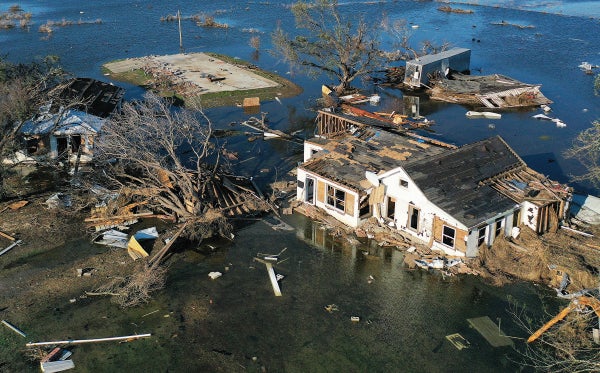The U.S. experienced 22 disasters last year that each caused at least $1 billion in damage, shattering a previous record and reflecting the increasing cost of climate change, according to NOAA.
The billion-dollar disasters of 2020 were led by Hurricane Laura, a Category 4 storm that caused $19 billion in damage and 42 deaths when it slammed the Louisiana coast in August. The list of disasters is composed almost exclusively of hurricanes, storms and tornadoes.
“2020 stands head and shoulders above all other years in regard to the number of billion-dollar disasters,” NOAA said.
On supporting science journalism
If you're enjoying this article, consider supporting our award-winning journalism by subscribing. By purchasing a subscription you are helping to ensure the future of impactful stories about the discoveries and ideas shaping our world today.
Altogether, the disasters caused $95 billion in damage and killed 261 people.
NOAA counted the wildfires that swept across the West last year as a single disaster, raising questions about whether they should be considered multiple tragedies. The deadly blazes blackened huge stretches of California, Colorado and Oregon.
NOAA’s database of “billion-dollar weather and climate disasters” catalogues every natural disaster since 1980 that caused at least $1 billion in damage and is widely cited by lawmakers, scientists and climate advocates.
The agency published its count for 2020 on Friday and said the 22 events signal a trend of growing disasters that have caused $2.2 trillion in damage since 1980.
The previous record was 16 billion-dollar disasters. It was set first in 2011 and again in 2017.
NOAA’s findings renewed calls for action to curb climate change. The report was released less than two weeks before President-elect Joe Biden takes office.
“Reining in climate change must be one of our highest priorities,” former NOAA Administrator Jane Lubchenco wrote on Twitter on Saturday in response to the agency’s 2020 data.
Friends of the Earth wrote on Twitter, “This is exactly why we cannot afford anything less than real, substantive action.”
Climate change and the nation’s growing population and wealth in vulnerable areas are driving the rise in U.S. disaster costs, NOAA said.
“The increase in population and material wealth over the last several decades are an important cause for the rising costs,” NOAA scientists led by Deke Arndt, head of the agency’s climate monitoring branch, wrote on NOAA’s website. “Much of the growth has taken place in vulnerable areas like coasts and river floodplains. Vulnerability is especially high where building codes are insufficient for reducing damage from extreme events.”
NOAA added: “Climate change is also playing a role in the increasing frequency of some types of extreme weather that lead to billion-dollar disasters—most notably the rise in vulnerability to drought, lengthening wildfire seasons in the Western states, and the potential for extremely heavy rainfall becoming more common in the eastern states. Sea level rise is worsening hurricane storm surge flooding.”
NOAA temperature data, which was posted separately on its website Friday, shows that 2020 was the fifth hottest year in the U.S. since the agency began keeping records in 1895. The five hottest years in the U.S. have occurred since 2012.
NOAA’s disaster report is the latest documentation of costly climate trends for 2020.
Global reinsurer Munich Re reported last week that disasters worldwide in 2020 caused $210 billion in damage—one of the costliest years on record—including $95 billion in U.S. damage (Climatewire, Jan. 8).
The European Union’s Copernicus Climate Change Service said global temperatures in 2020 tied with 2016 for the hottest year on record (Climatewire, Jan. 8).
The National Interagency Fire Center posted statistics showing that wildfire burned a record 10.3 million acres in the U.S. last year, breaking the previous record of 10.1 million acres, set in 2015.
President Trump declared three major disasters for wildfires last year—two in California and one in Oregon—and the Federal Emergency Management Agency made 78 fire management assistance declarations, which provide states with limited federal funds for firefighting. The FEMA declarations were in nine Western states as well as Oklahoma and Florida.
But NOAA counted all the U.S. wildfires as a single billion-dollar disaster—“the Western wildfires”—that caused $16.5 billion in damage.
That raised questions on Twitter from people who said the agency was minimizing the wildfires and should count distinct blazes as separate events.
The National Interagency Fire Center recorded 58,258 separate wildfires in 2020.
The California Department of Forestry and Fire Protection recorded 9,639 wildfires in the state last year between Feb. 15 and Dec. 23.
NOAA said on Twitter that it has historically counted wildfires as well as droughts as a single “regional-scale season-long event.”
In addition to U.S. wildfires and drought, the 22 billion-dollar disasters in 2020 included seven hurricanes and 13 severe storms, led by the derecho that swept across the Midwest in August and caused $11 billion in damage.
Billion-dollar disasters account for an increasing share of the overall damage caused by catastrophes each year, NOAA said. Since 1980, the nation’s 285 billion-dollar disasters have accounted for 85% of the $2.2 trillion in disaster costs in the U.S.
Reprinted from E&E News with permission from POLITICO, LLC. Copyright 2021. E&E News provides essential news for energy and environment professionals.
